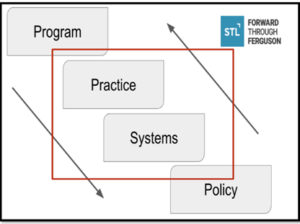What is a STEM Ecosystem?
“A STEM Learning Ecosystem encompasses schools, community settings such as after-school and summer programs, science centers and museums, and informal experiences at home and in a variety of environments that together constitute a rich array of learning opportunities for young people. A learning ecosystem harnesses the unique contributions of all these different settings in symbiosis to deliver STEM learning for all children. Designed pathways enable young people to become engaged, knowledgeable and skilled in the STEM disciplines as they progress through childhood into adolescence and early adulthood”
–STEM Learning Ecosystem
Why does STL need a STEM Ecosystem?
As noted in the Greater STL Inc. 2030 jobs plan, St. Louis business leaders have identified five workforce clusters, (Business Services, Biomedical Sciences, Advanced Manufacturing, Aerospace, and Transportation and Logistics) that are driving economic growth in the St. Louis area. STEM learning is an important aspect in each of these clusters, so it is important that as student leave high school, vocational schools, or higher educations, they will have the skill and education necessary to compete in the local job market, at all levels.
–Read the full STL Jobs Plan
What is a Community of Practice?
A community of practice is a group of people who share a concern or a passion for something they do, and learn how to do it better as they interact regularly. Within the context of STEMSTL, out-of-school-time STEM programs provide an important point of exposure for many St. Louis students to STEM concepts and project-based STEM learning. One of the strategic priorities identified in the STEMSTL Strategic plan is to establish standard definitions of quality and Anti-Biased/Anti-Racist STEM Learning across all types of STEM programing and work based Learning. Our Community of Practice program is design to accomplish this strategic initiative. STEMSTL has partnered with Strategic Community Partners, who are the experts in this work, to facilitate the program.
Does STEMSTL provide direct programing?
The short answer is no but one of our primary focuses is help the people, who do provide direct programming. We have developed a pool of resources to help instructors, educators, and parents find information, programming, and professional developments in the greater St. Louis Area related to STEM Learning.
What is Systems Change?
Systems change means to fundamentally, and on a large scale, changing the way a majority of relevant players solve a big social challenge, such that a critical mass of people affected by that problem substantially benefit.
The image below is a visual example of where systems change work function. STEMSTL works at the systems section of the diagram.

How is Systems Changes different than traditional programing?
Systems Change initiatives affect the way systems (for example cities, government, school districts, or historic customs) disadvantage underserved communities, whereas traditional programing provides resources or programs directly to the communities to mitigate the impacts from being underserved by the system.
How can I get Involved with STEMSTL?
Participating is as easy as attending one of our monthly roundtables to talk about common topics around the work of STEM equity work. However if your are interested in more hands on work, considers joining one of our five work groups focused around accomplishing our Strategic Goals. Joining is easy as sending us a message on the connect with us page.
What is are STEMSTL Work Groups?
STEMSTL has five work groups that help support the full time staff of STEMSTL accomplish our strategic initiative while also including a community voice with in our work. We believe collective work helps accomplish meaningful change in a community. Work group members are volunteers from the community and knowledgeable in their field of work. Each work group focused on different projects related to their focus area (Connection to the Workforce, Centralizing Communications, Strengthening the Ecosystem, Identifying and Filling Gaps, and Supporting Quality and Rigor). Learn more about the work here!